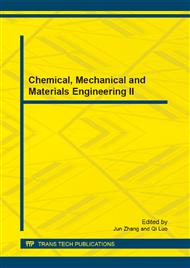[1]
Alves J J. Analysis and Design of Refinery Hydrogen Distribution Systems. Ph.D. Thesis, University of Manchester Institute of Science and Technology, Manchester, U.K. (1999).
Google Scholar
[2]
Alves J J, Towler G P. Analysis of Refinery Hydrogen Distribution Systems. Industrial & Engineering Chemistry Research. Forum Vol.41(23) (2002), P. 5759–5769.
DOI: 10.1021/ie010558v
Google Scholar
[3]
El-Halwagi M, Gabriel F, Harell D. Rigorous Graphical Targeting for Resource Conservationvia Material Recycle/Reuse Networks. Industrial & Engineering Chemistry Research. Forum Vol. 42(19) (2003), P.4319–4328.
DOI: 10.1021/ie030318a
Google Scholar
[4]
Zhao ZH, Liu GL, Feng X. New Graphical Method for the Integration of Hydrogen Distribution Systems. Ind Eng Chem Res. Forum Vol. 45(19) (2006), P. 6512-6517.
DOI: 10.1021/ie0604223
Google Scholar
[5]
Agrawal V, Shenoy U V. Unified Conceptual Approach to Targeting and Design of Water and Hydrogen Networks. AIChE J. Forum Vol. 52(3) (2006), P. 1071–1082.
DOI: 10.1002/aic.10724
Google Scholar
[6]
Ng D K S, Foo D C Y, Tan R R. Automated Targeting Technique for Single- impurity Resource Conservation Networks. Part 1: Direct Reuse/Recycle. Industrial & Engineering Chemistry Research. Forum Vol. 48(16) (2009), P. 7637–7646.
DOI: 10.1021/ie900120y
Google Scholar
[7]
Ng D K S, Foo D C Y, Tan R R. Automated Targeting Technique for Single- impurity Resource Conservation Networks. Part 2: Single-pass and Partitioning Waste-intercetion Systems. Industrial & Engineering Chemistry Research. Forum Vol. 48(16) (2009), P. 7647 – 7661.
DOI: 10.1021/ie900127r
Google Scholar
[8]
Qiao Zhang, Xiao Feng, Guilian Liu, Khim H Chu. A Novel Graphical Method for the Integration of Hydrogen Distribution Systems with Purification Reuse. Chemical Engineering Science. Forum Vol. 66(4) (2011), P. 797–809.
DOI: 10.1016/j.ces.2010.11.044
Google Scholar
[9]
Liu F, Zhang N. Strategy of Purifier Selection and Integration in Hydrogen Networks. Chemical Engineering Research & Design. Forum Vol. 82(A10) (2004), P. 1315–1330.
DOI: 10.1205/cerd.82.10.1315.46739
Google Scholar
[10]
Zhang Yi, Yang Yongrong, Liu Jun, Guo Hongxin, Tang Yinggang. Hydrogen network integrative management in refinery. Acta Petrolei Sinica (Petroleum Processing Section). Forum Vol. 20(1) (2004), P. 58–62.
Google Scholar
[11]
Liu Yongzhong, Zhang Chao, Peng Chunlai, Feng Xiao. The optimization of usage of hydrogen utility and matchnumber in a hydrogen distribution network. Acta Petroleui Sinica. Forum Vol. 23(4) (2007), P. 78–83.
Google Scholar
[12]
Xuan Ji, Liao Zuwei, Rong Gang, Yang Yongrong.Hydrogen network retrofit design in refinery based on stochastic programming. Journal of Chemical Industry and Engineering. Forum Vol. 61(2) (2010), P. 398–404.
Google Scholar
[13]
Zu-Wei Liao, Gang Rong, Jing-Dai Wang, Yong-Rong Yang. Rigorous Algorithmic Targeting Methods for Hydrogen Networks —Part I:Systems with no Hydrogen Purification. Chemical Engineering Science. Forum Vol. 66(4) (2011), P. 813–820.
DOI: 10.1016/j.ces.2010.10.018
Google Scholar
[14]
Zu-Wei Liao, Gang Rong, Jing-Dai Wang, Yong-Rong Yang. Rigorous Algorithmic Targeting Methods for Hydrogen Networks—Part II:Systems with One Hydrogen Purification Unit. Chemical Engineering Science. Forum Vol. 66(4) (2011), P. 821–833.
DOI: 10.1016/j.ces.2010.10.019
Google Scholar
[15]
Hallale N, Moore I, Vauk D. Hydrogen Optimization at Minimal Investment. Petroleum Technology Quarterly. Forum Vol. Q1 (2003), P. 83-90.
Google Scholar
[16]
Zhao Zhenhui, Liu Guilian, Feng Xiao. The Integration of the Hydrogen Distribution System with Multiple Impurities. Chemical Engineering Research & Design. Forum Vol. 85 (A9) (2007), P. 1295-1304.
DOI: 10.1205/cherd07014
Google Scholar
[17]
Liu Guilian, Tang Mingyuan, Feng Xiao. Optimization of hydrogen network with multi–impurities. Petrochemical Technology. Forum Vol. 38(4) (2009), P. 419–422.
Google Scholar
[18]
Ding Ye , Feng Xiao, Liu Guilian. Improved method of mass-exchange network with multiple impurities deficit diagram. Journal of East China University of Science and Technology (Natural Science Edition). Forum Vol. 35(4) (2009), P. 521–524.
Google Scholar
[19]
Ding Ye, Feng Xiao. Design for hydrogen network with multiple impurities. Journal of Xi'an Jiaotong University. Forum Vol. 44(8) (2010), P. 127–131.
Google Scholar
[20]
Liu Guilian, Liu Yongbiao, Feng Xiao. Integration of refinery hydrogen network with multiple impurities.Journal of Chemical Industry and Engineering. Forum Vol. 63(1) (2012), P. 163-169.
Google Scholar
[21]
Liu Zhi-Yong, Yang Yi, Wan Lin-Zhan, Wang Xi, Hou Kai-Hu. A heuristic design procedure for water-using networks with multiple contaminants. AIChE J. Forum Vol. 55(2) (2009), P. 374–382.
DOI: 10.1002/aic.11693
Google Scholar
[22]
Pan Chunhui, Wang Huanyun, Zhang Cuiying. Design of hydrogen distribution networks by source matching method. Chemical Engineering). Forum Vol. 40(5) (2012), P. 18 -22.
Google Scholar
[23]
Pan Chun-Hui, Shi Jing, Liu Zhi-Yong. An iterative method for design of water-using networks with regeneration recycling. AIChE J. Forum Vol. 58 (2) (2012), P. 456-465
DOI: 10.1002/aic.12595
Google Scholar


